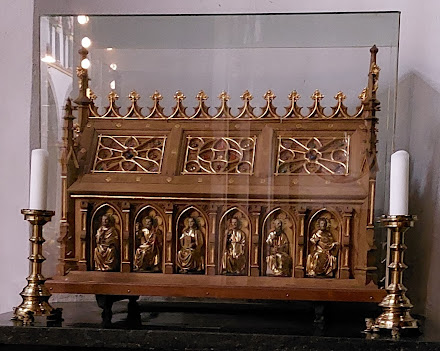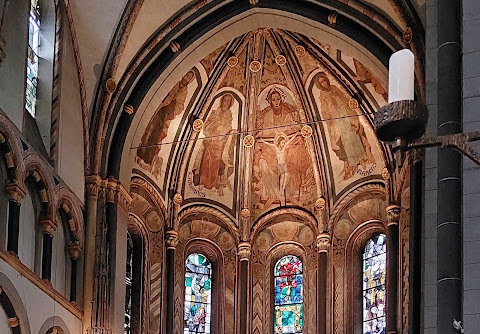In 1989 I wrote an assignment for my studies about a church in Düsseldorf, Germany. Yesterday I passed the urban district of Gerresheim and took the chance to visit the basilica St. Margaretha again.
The basilica was sanctified in 1236 and symbolizes the transition from roman to gothic architecture. The most stunning detail is the octogonal spire on top of the intersection and the folded rooftop.
It is built of tuff, which is typical for the roman churches in this aera
the main entrance
The shrine with relics of St. Hippolyth (1871, neo-gothic era). The saint was a priest and martyr from the early 3rd century and he's the patron of the first church sonated by Gerricus. The relics of St. Hippolyth were taken to Cologne during an assault of Hungarians in 919 and were transferred back to St. Margaretha in 1953!
The niche on the left side hides a relic with tiny parts from the cross
Entry to the treasury. Most important relic is a tiny stone from Golgatha, saturated with the blood of Jesus Christ. Most important work of art is an evangeliar from 1020/1040 (Ottonian era). Entry and guide only with permission!
Above the main altar is a huge, 1,8 x 2,1 m crucifix made of oak in the late 10th c.
On the left side of the choir is a "sacrament" made of sandstone.
Made in Straelen, Northrhine Westfalia, in the 16th century, it looks like a pure, late-gothic monstrance of 10 metres height. On the left is another niche with relics, created in the same era, same atelier.
Hidden in the dark on a candleholder (2,13m high) is the
"Virgin with Aureole", made of oak, Netherlands, late 15th century. 0,83 m high
The apse shows the holy trinity: godfather with his crucified son and a dove between them. on the left and right side are all four evangelists.The name of this special "trinity" is called throne of grace
Before I left the basilica, I lighted a candle in front of an icon of the so-called "Virgin of Vladimir". I don't know where this copy comes from, who made it and how old it is.
The antique icon was painted in the 12th century in Byzanz and was taken to Russia. Today it is on display at the Tretyakov Gallery, Moscow.










.jpg)

.jpg)



No comments:
Post a Comment